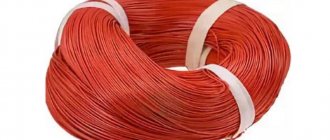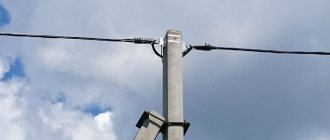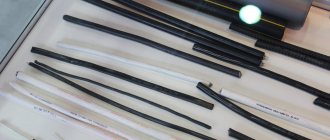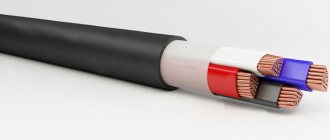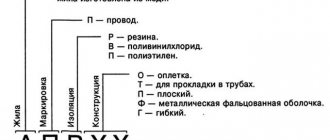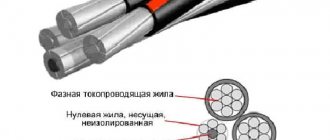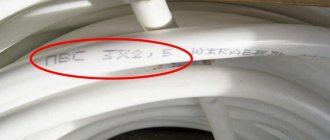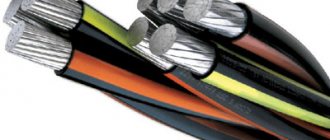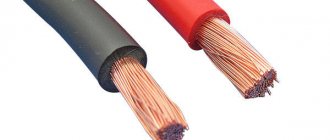To organize power power lines, overhead lighting lines, as well as to create a branch from the main electrical line to the entrance to residential premises in a temperate or cold climate zone, self-supporting insulating wires or SIPs are used. They are designed to operate with a voltage of 600/1000V inclusive and a nominal frequency of 50Hz. There are cables designed for voltages of 20 kV and 35 kV.
Self-supporting insulated wire
Types of SIP
According to GOST 31946-2012 “Self-supporting insulated and protected wires for overhead power lines,” there are several types of self-supporting insulated wires, each of which has its own design features.
SIP wires are produced by industry according to the description given in the technical specifications.
SIP cable design
All cables consist of cores (conductors) twisted into a bundle. There are three types:
- Zero – can serve as a neutral, protective or protective-neutral conductor. Made with a cross section from 25mm2 to 95mm2;
- Main or phase - designed to transmit electric current to the consumer. Products are produced with quantities from 2 to 4 cores. Their cross-section can range from 16mm2 to 240mm2;
- Auxiliary or lighting – used to connect lighting, measuring and relay devices.
Wire design SIP 2 and SIP 1
The phase conductor, like the neutral conductor, consists of aluminum wires that are twisted into a bundle around the core. For the phase core, the core is made of aluminum, and for the zero core, it is made of steel.
There are products without a zero core. They are lighter and have a smaller cross-section.
Lighting, phase and neutral conductors must be tightly twisted from rounded aluminum wires and have a rounded shape. Auxiliary conductors intended for control circuits are made of single-wire copper wire.
Phase conductors are isolated from each other. Depending on the design, the zero phase may or may not be covered with insulation. Light-stabilized silanol cross-linked polyethylene and thermoplastic PET, which has stable lighting performance, are used as insulators.
Light-stabilized silanol cross-linked polyethylene has excellent resistance to moisture and ultraviolet rays. This PET has a wide-cellular three-dimensional molecular structure, which is formed due to cross-links between molecules.
Thanks to this, a durable dielectric is obtained, resistant to mechanical damage, which can withstand high (up to 90°C) and low temperatures. For a short time (within 5s) it can withstand temperatures up to 250°C.
For each core, according to the Electrical Installation Rules, its own color marking is used.
Color marking for SIP-2 cable cores
Attention! The neutral support wire is usually marked in blue.
Types of cables
Depending on the design and purpose, the following types of self-supporting insulating wires are distinguished:
- with uninsulated neutral core;
- with insulated neutral core;
- without zero load-bearing core.
The first type is also called “naked”. This includes cable SIP 1.
The second option has an insulated neutral wire. This type includes wires of the SIP 2 brand.
The following types do not include a neutral wire. These include classes SIP 3 and SIP 4.
SIP 3 is a single-core cable with a steel core with protective insulation. SIP 4 does not have a load-bearing element.
Also, at the customer's request, sealed cables can be produced. In this case, the symbol “g” is added to the abbreviation SIP.
If the conductor does not spread fire, then in this case the cable brand has an additional letter “n”.
They also produce brands SIP 1A and SIP 2A.
Scope of application of SIP-2 wire
Unlike bare wires, SIP-2 insulation protects conductors from overlap, and, consequently, from short circuits. SIP wire is a modern replacement for bare wires, allowing the construction of power lines in difficult climatic and operating conditions. There are five types of SIP wires. The main feature of the entire brand is the insulated current-carrying part. The SIP-2 wire is designed, unlike other wires of this brand, to work in adverse weather conditions. SIP-2 wires are intended for creating branches and distribution networks of industrial and private scale.
SIP-2 wires are installed in alternating current networks with a voltage of 0.66 and 1 kV with a frequency of 50 Hz. Installation of SIP-2 wire is carried out both on supports and on structural elements of buildings, usually on walls.
It is possible to install wires inside buildings and closed structures. They do not spread fire when laid alone.
Cable designation
KG cable - decoding and technical characteristics
According to GOST, the marking of conductors should look like:
- The first symbols are “SIP”, indicating the type of conductor;
- The numbers from 1 to 4 are indicated with a hyphen;
- At intervals, numbers are added that indicate the number of each type of core, then through the multiplication sign - their cross-section. Numbers related to each type are separated from each other by a “+” sign;
- A dash indicates the rated voltage of the cable;
- Technical specifications may also be indicated at intervals.
For example, if the marking SIP-2 3×70 + 1×95 + 2×25 - 0.6/1 TU is indicated, then the parameters of the self-supporting insulated wire are as follows:
- designed for organizing overhead power lines;
- has veins:
- 3 main sections 70mm2;
- 1 insulated carrier with a cross-section of 95mm2;
- 2 auxiliary sections 25mm2.
- The cable is designed for voltage 0.6/1 kV.
How to correctly install SIP-4: choosing fittings
To install SIP-4, you need to use special fasteners. The appropriate fittings allow you to quickly and without harm to the insulation of the cores, lay the wire along the facade of the building, secure it to a pole and other structures. To connect current-carrying wires to each other, you must use suitable couplings with torque tension.
The main purpose of reinforcement is that it is indispensable when creating connections and other tasks. The fittings for this type of electrical products are special linear elements for the main line, the voltage of which is no more than 0.6/1 kV. Laying can be carried out on the facade, supports for overhead lines. Thanks to special fastening elements, it is possible to connect new subscribers and carry out various work at the substation. Moreover, fittings are used to contact insulated wires with bare wires, while outdated electrical networks with wires without insulation are being reconstructed into more modern self-supporting ones.
Fixing the wire requires the use of various elements. Fittings for insulated wire include:
- clamps - depending on the purpose and the support used, a variety of elements are used: from anchor to supporting and branch;
- brackets;
- insulated tips;
- special clamps for installing self-supporting insulated wires that do not have a supporting core;
- sleeves;
- bandage strip, clamp or yoke;
- tensioning tools.
When installing self-supporting wires, you need to know that durable reinforcement is the key to safe and qualified installation of SIP-4. Only if you choose fittings of high strength and reliability, and competently carry out all the necessary work, will it be possible to create a wear-resistant, high-quality overhead power line that will function uninterruptedly for many years without the need for repairs, short circuits and other emergencies.
Advantages and disadvantages of the product
Wall chaser - types and technical characteristics
The advantages of self-supporting insulating wires include:
- Fast and convenient installation and maintenance;
- Electricians installing cables do not need to precisely measure the distance between wires;
- Does not require additional insulators;
- Losses are reduced due to the fact that the reactance in a SIP cable is three times less than in a bare wire;
- Aesthetic appearance;
- It is possible to branch power lines without de-energizing the system. There are special clamps that are used to puncture the insulation, and the clamps themselves fit tightly to the live wires.
Installation of self-supporting insulating wires
The disadvantage of SIP type cable is the large weight of one meter of cable, which entails the need to place supports at a closer distance.
Operating conditions for SIP wire 4 4x10
- Type of climatic modification B, placement category 1, 2, 3 according to GOST 15150.
- Operating temperature range from -60 °C to 50 °C.
- Installation is carried out at an ambient temperature of at least -20 °C.
- The bending radius of the wire during installation is at least 10 calculated outer diameters.
- The electrical resistance of current-carrying conductors to direct current, recalculated for a temperature of 20 ° C and 1 km of length corresponds to GOST 22483.
- The specific volumetric resistance of the insulation at the long-term permissible heating temperature of the current-carrying conductors is not less than 1x1012 Ohmxcm.
- Permissible heating of current-carrying conductors during operation is no more than 90 °C.
- The permissible heating of current-carrying conductors during operation with a short circuit is no more than 250 °C.
- The wire is resistant to solar radiation.
The wire is resistant to cyclic exposure to a complex of atmospheric factors:
- exposure to solar radiation;
- exposure to temperature (70±2) °C;
- exposure to rain;
- exposure to temperature minus (40±2) °C;
- The service life of the wires is at least 40 years.
The warranty period is 3 years from the date of commissioning of the wire, but no later than 6 months. from the date of manufacture.
Technical characteristics of SIP 2 cable
SIP 2 wire is produced with the following technical characteristics:
- the number of conductors can be from 1 to 4;
- the cross section is in the range of 16-120 mm2;
- the zero core is made of aluminum alloy and has a steel core;
- rated voltage – 0.6-1 kV;
- insulation material – light-stabilized silanol cross-linked polyethylene;
- relative humidity of the operating environment – up to 98%;
- the minimum bending radius is 10D, where D is the diameter of the wire;
- installation of the wire is allowed at a temperature of at least -20°C;
SIP cable
Temperature parameters:
- Operating temperature range – -60°С – +50°С. Thanks to these properties, the cable can be used when laying electrical networks in a cold climate zone;
- Heating up to +90°C for 8 hours is allowed;
- Short-term heating up to 130°C is allowed;
- The permissible short circuit temperature is +250°C.
Attention! During operation, heating up to 90°C is possible. It is allowed to be allowed for no more than 8 hours per day, no more than 100 hours per year, and no more than 1000 hours for the entire period of work.
The warranty period is at least 3 years, the service life must be at least 40 years.
Strength characteristics of SIP 2
| Nominal cross-section of zero and main cores, mm2 | Core tensile strength, kN, not less |
| 25 | 7,4 |
| 35 | 10,3 |
| 50 | 14,2 |
| 70 | 20,6 |
| 95 | 27,9 |
| 120 | 35,2 |
| 150 | 43,4 |
| 185 | 53,5 |
| 240 | 69,5 |
Depending on the number of cores and their cross-section, cables have different weights and diameters.
Characteristics of the diameter and weight of SIP 2 wire
| Number and cross-section of cores | Outer diameter of wire, mm | Weight of 1 km of wire, kg |
| 1x16 + 1x25 | 16,4 | 167 |
| 3x16 + 1x25 | 24,1 | 307 |
| 3x25 + 1x35 | 27,1 | 424 |
| 3x35 + 1x50 | 30,8 | 570 |
| 3x50 + 1x50 | 34,1 | 729 |
| 3x50 + 1x70 | 36,1 | 799 |
| 3x70 + 1x70 | 40,0 | 1010 |
| 3x70 + 1x95 | 41,8 | 1086 |
| 3x95 + 1x70 | 44,2 | 1247 |
| 3x95 + 1x95 | 45,9 | 1323 |
| 3x120 + 1x95 | 48,1 | 1545 |
| 3x150 + 1x95 | 50,9 | 1812 |
| 3x185 + 1x95 | 55,0 | 2162 |
| 3x240 + 1x95 | 59,6 | 2652 |
| 4x16 + 1x25 | 24,1 | 377 |
| 4x25 + 1x25 | 27,1 | 522 |
Technical characteristics of SIP wire 4 4x10
Main and auxiliary conductors:
- Aluminum stranded, round, compacted.
Insulation:
- Made from light-stabilized cross-linked polyethylene.
- Insulated main conductors must have a distinctive marking in the form of colored longitudinal stripes with a width of at least 1 mm. The color of the stripes should be contrasting with black. Auxiliary conductors for lighting circuits must have a distinctive designation: “B1”, “B2”, printed. The insulation of the main and auxiliary conductors is black.
Twist:
- The insulated main and auxiliary conductors must be twisted together. The twisting of insulated conductors into a wire must be in the right direction. At the customer's request, wires of the SIP-4 brand can be manufactured with 1 or 2 auxiliary conductors for external lighting circuits. Nominal cross-section of auxiliary conductors 16; 25 or 35 mm2.
Accessories for working with self-supporting insulating wires
Additional accessories are used for operation:
- piercing clamp;
- support clamp;
- brackets and brackets for poles;
- load-bearing core tensioner;
- wedge clamp, etc.
Installation of power lines using a piercing clamp
The use of SIP cables allows you to quickly and efficiently install the electrical network.
Wire (cable) SIP-4 2x25 description
Wire SIP-4 2x25 is a self-supporting two-core wire. The material from which the wire is made is high-quality aluminum.
Wire (cable) SIP-4 2x25, the technical characteristics of which fully comply with GOST, is suitable for use in a wide temperature range from minus 60 to plus 50 degrees Celsius. Moreover, installation is possible at temperatures down to minus 20 degrees. Self-supporting insulated wire is highly resistant to external influences, such as solar radiation, rain and other atmospheric phenomena. The wire does not emit harmful substances that have a negative impact on the atmosphere.
